Reviewer's Note: The Fenix LD10 (R4) and LD20 (R4) were provided for review by the Canadian Fenix distributor Notosora International Imports Ltd.
Warning: pic heavy as usual!
Specifications for LD10/20 (R4), adapted from Fenix, Notosora and other websites:
 Here's a chance to see how the new LD10/20 versions equipped with XP-G R4 emitters stack up to the earlier "torch-bearers" from Fenix.
Here's a chance to see how the new LD10/20 versions equipped with XP-G R4 emitters stack up to the earlier "torch-bearers" from Fenix.
As it just so happens, I have the earlier LD10/20 Q5, as well as all iterations of the original LxD (Q5, Q2, P4 and short-lived Rebel R100) to compare to. Time for a
Since the lights use the same head and come in effectively the same packaging, I will focus on the LD20 for most of the product shots below (the LD10 looks the same, just shorter! ). Where the difference is important, I'll show both lights.
). Where the difference is important, I'll show both lights.
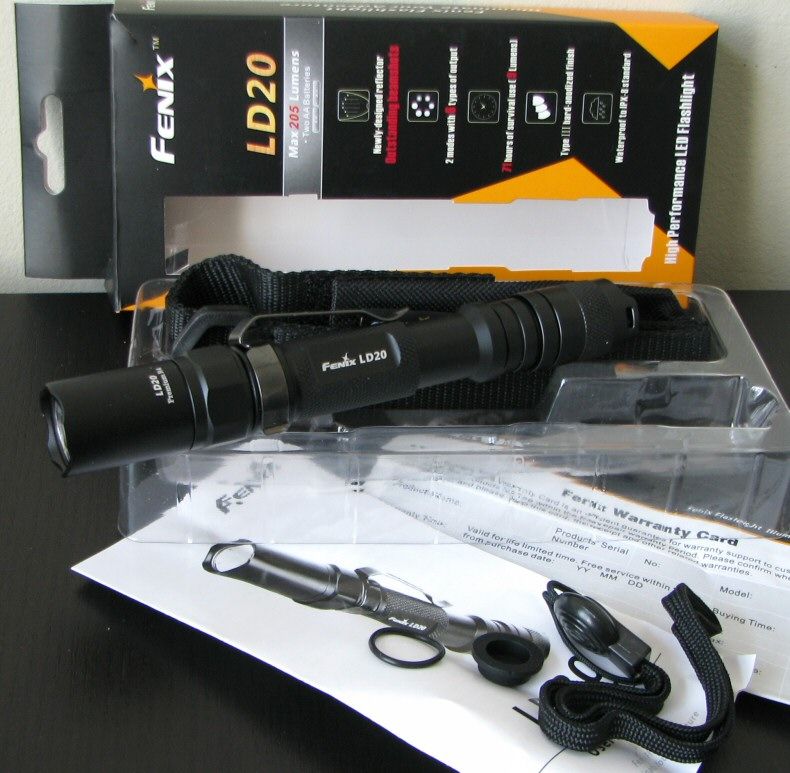
The LD10/20-R4s come in the new standard Fenix packaging. Included inside the thin cardboard box with molded plastic insert is the light along with a manual, warranty card, titanium-coated clip, spare o-rings, extra black tailcap boot cover, wrist lanyard, and belt pouch with closing flap.
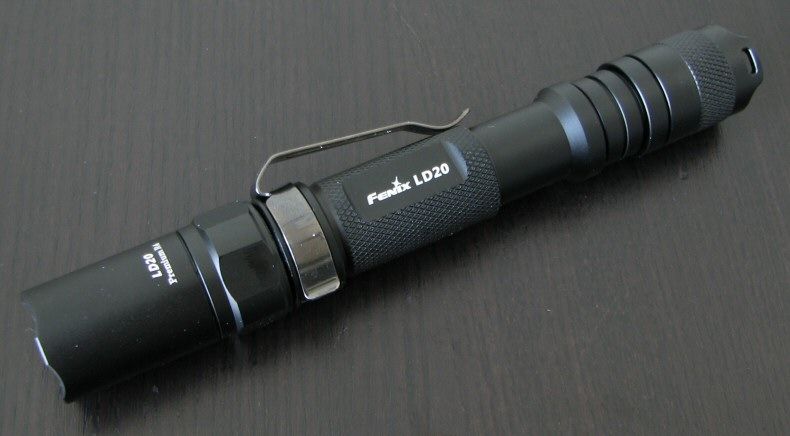
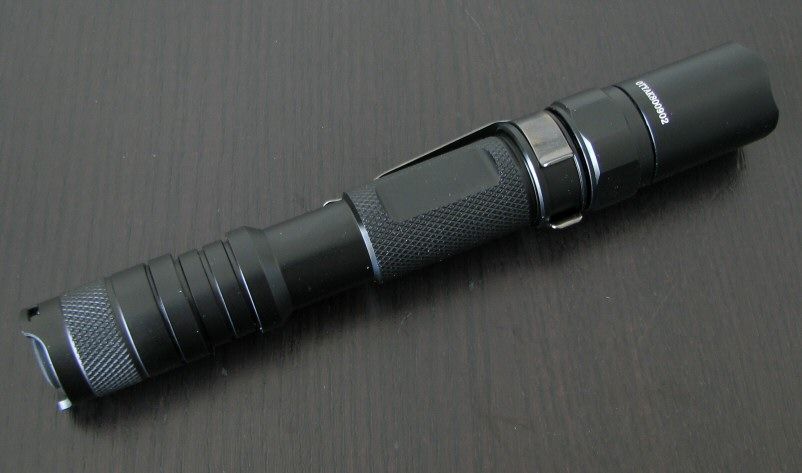
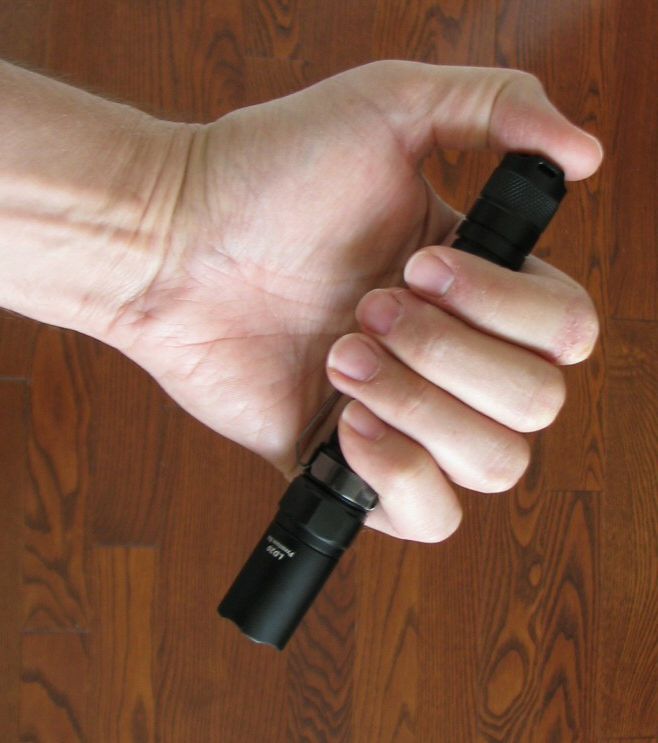
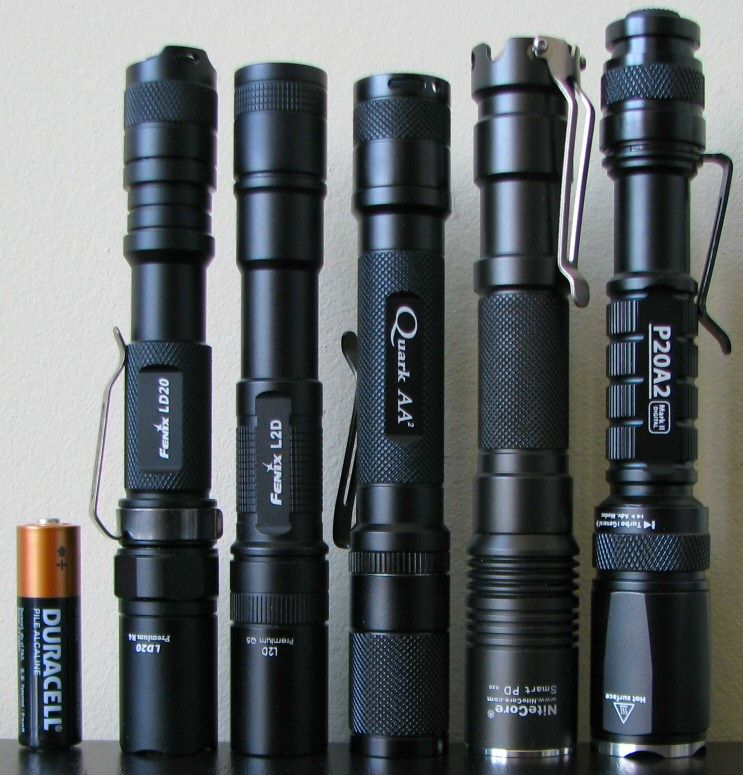
From left to right: Duracell alkaline battery, Fenix LD20-R4, Fenix L2D-Q5, 4Sevens Quark AA-2, NiteCore D20, EagleTac P20A2-II.
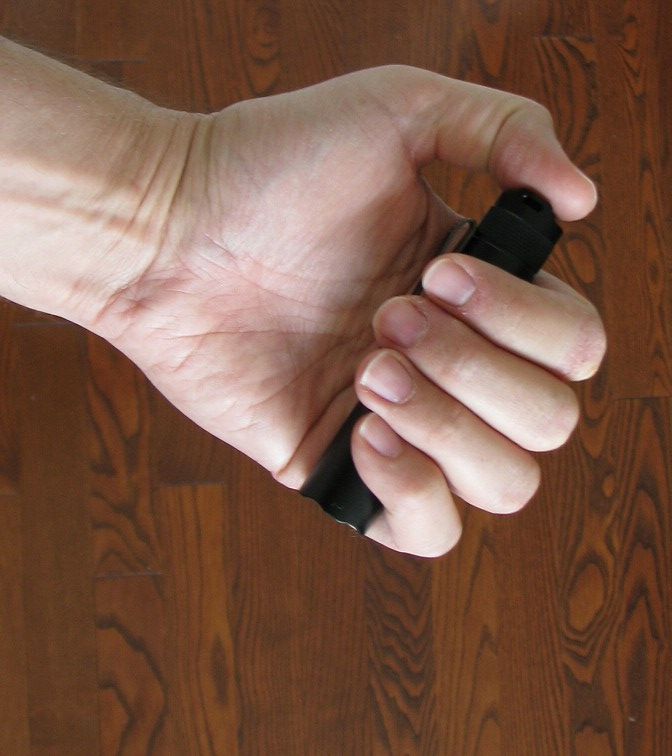
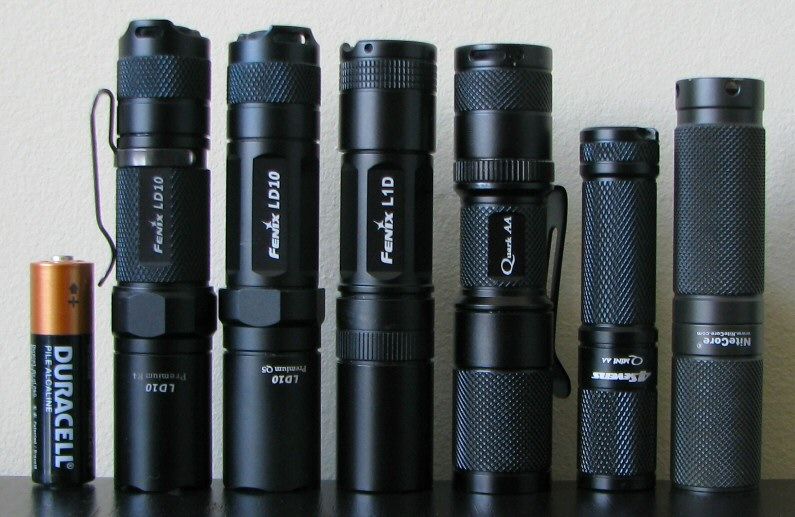
From left to right: Duracell alkaline battery, Fenix LD10-R4, Fenix LD10-Q5, Fenix L1D-Q5, 4Sevens Quark AA, 4Sevens Mini-AA, NiteCore D10.
Externally, the new LD10/20-R4s appear very similar to the original LD10/20 series lights. The most significant body change is that knurling has been added the body/battery tubes, and seems slightly more aggressive than what was previously used on the tailcaps. Identification labels are clear, although not as bright as the previous versions. Fit and finish are very good on my samples, with no flaws in the matte black type-III hard anodizing. :thumbsup:
New with these lights is the removable Fenix stainless steel pocket clip (with black titanium coating), very similar to the TK12-R5 I reviewed previously.
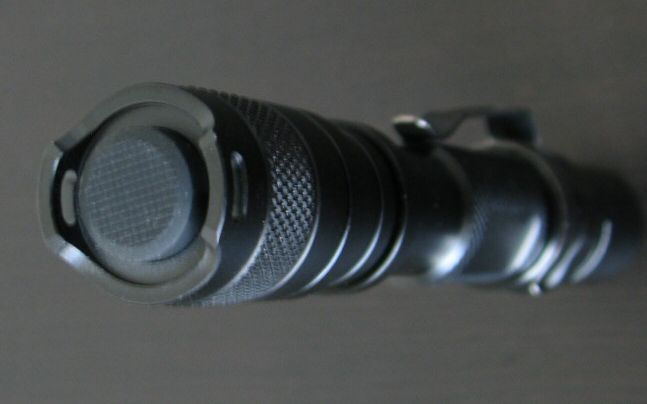
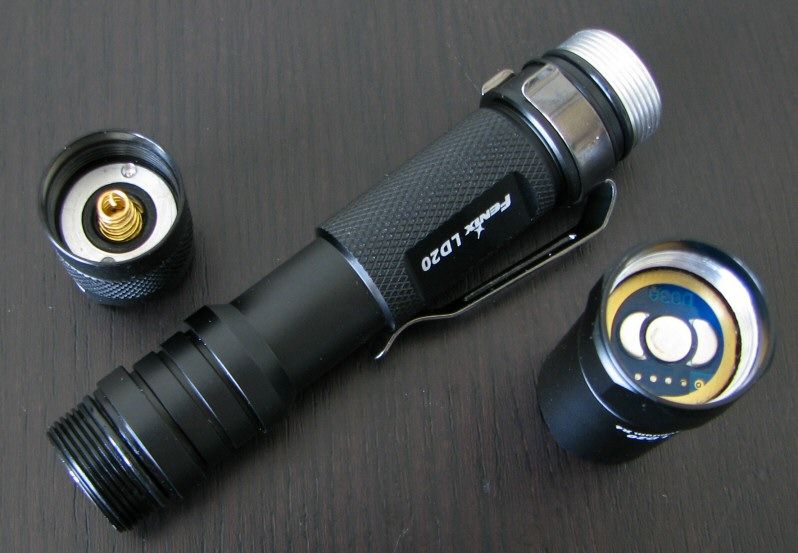
One thing that has changed is the screw threads – they are now square-cut on both the tail and head sections. While this is a nice feature in-and-of itself, it means the new versions are no longer backward-compatible with the parts from earlier generations. Up until these new lights, you could happily mix-and-match body and tailcap tubes from any previous Fenix version (i.e. LDx0-Q5 all the way down to the original LxD-P4). Now, you will need to stick with parts from this new generation. :shrug:
The tailcap threads are still anodized for tailcap lock-out, like before. Both LD10 and LD20 lights can still tailstand in their default stock forms.
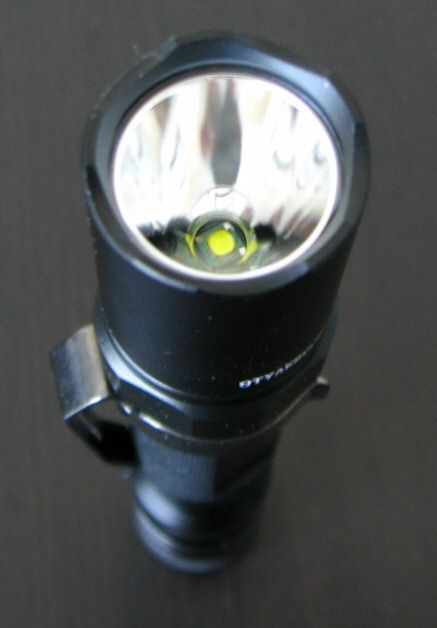
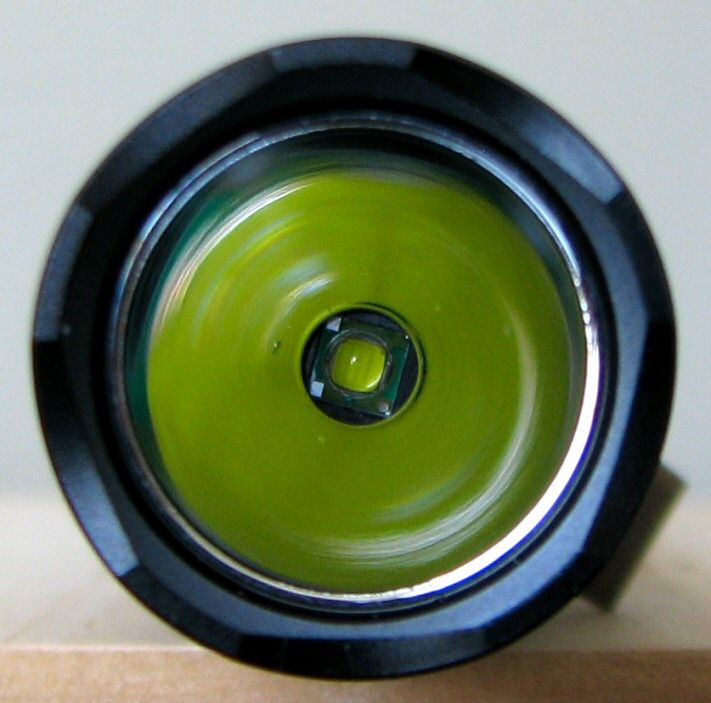
The new LD10/20 uses the new Cree XP-G emitter, with a cool-white R4 output bin (no tint bin reported). As you can see above, my samples came with a smooth reflector, but I believe OP textured is also available. Note that the reflectors are NOT user-swappable. You must buy one version or the other, so make sure you check first if it matters to you.
And now for the white wall hunting. Since both use the same head, I'm only showing the LD20 below. All lights are on Max on 2x Sanyo Eneloop NiMH, about 0.5 meters from a white wall.
Since both use the same head, I'm only showing the LD20 below. All lights are on Max on 2x Sanyo Eneloop NiMH, about 0.5 meters from a white wall.
Note: I accidentally put the wrong labels on the images below – they should all say LD20.
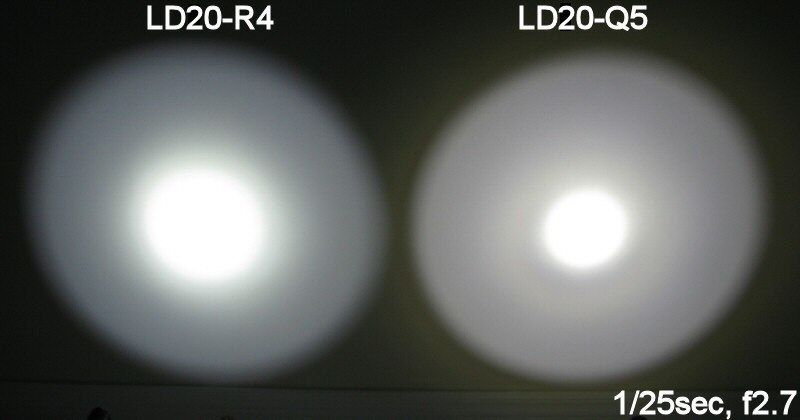
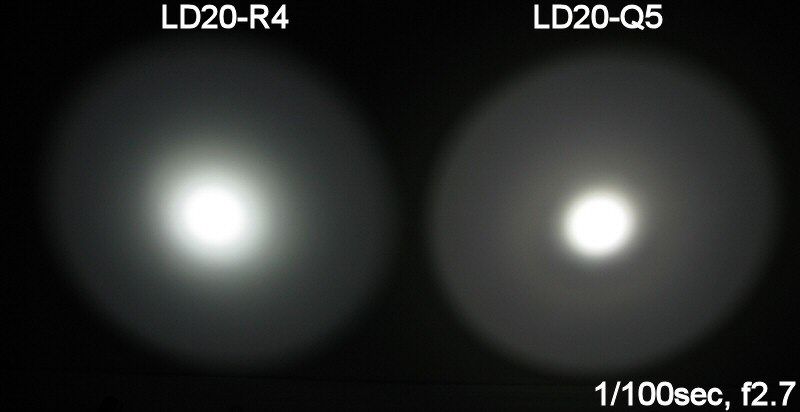
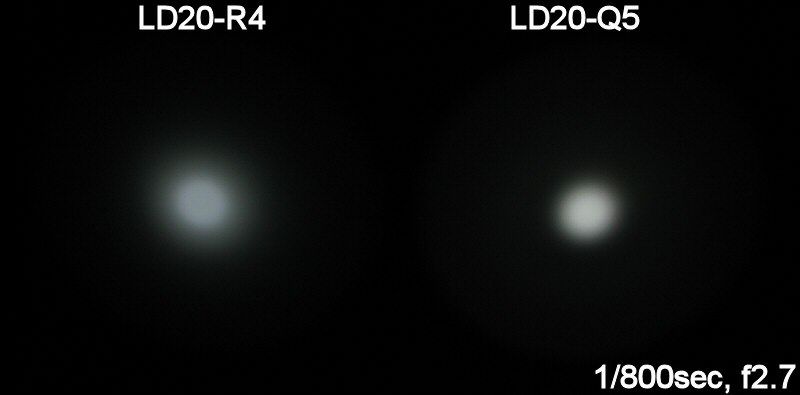
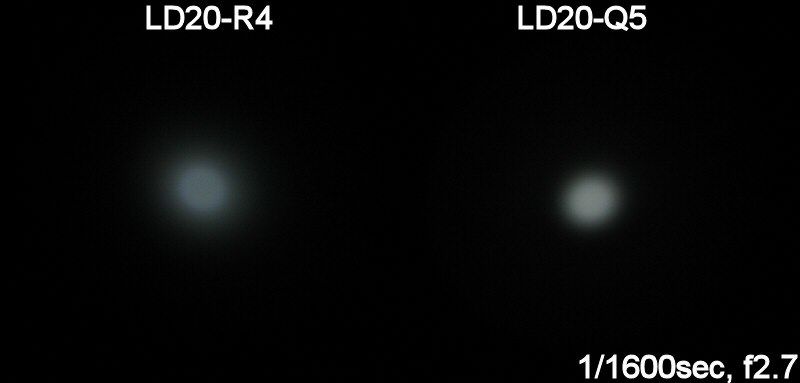
Even with the Smooth reflector, the LD20-R4 has a very even beam with no obvious rings (thanks to the XP-G emitter). It also has a larger and less defined hotspot than the L1D-Q5, with reduced centre-beam throw.
Like with many XP-G-based lights with smooth reflectors, there is some evidence of a slightly dark centre to the hotspot (i.e. a faint donut pattern). This is only noticeable at a distance – and only if you are looking for it. It is not at all distracting in this case.
User Interface
This hasn't changed from earlier model LD10/20 lights. All standard Fenix lights use a similar mechanism – tighten the head for Turbo modes, loosen the head slightly for the General modes.
For General modes, starting with the bezel slightly loosened, click on to activate Lo mode. Soft-press to advance to Med, Hi, SOS in sequence.
With the bezel fully tightened, activation yields Turbo. Soft-press to advance to rapid Strobe.
If you turn the light off-on within ~2 secs, you will advance to the next mode (i.e. acts as a soft-press). If you wait longer than that, you will return to the first output state (i.e. Lo or Turbo, depending on the bezel state). There is no long-term mode memory.
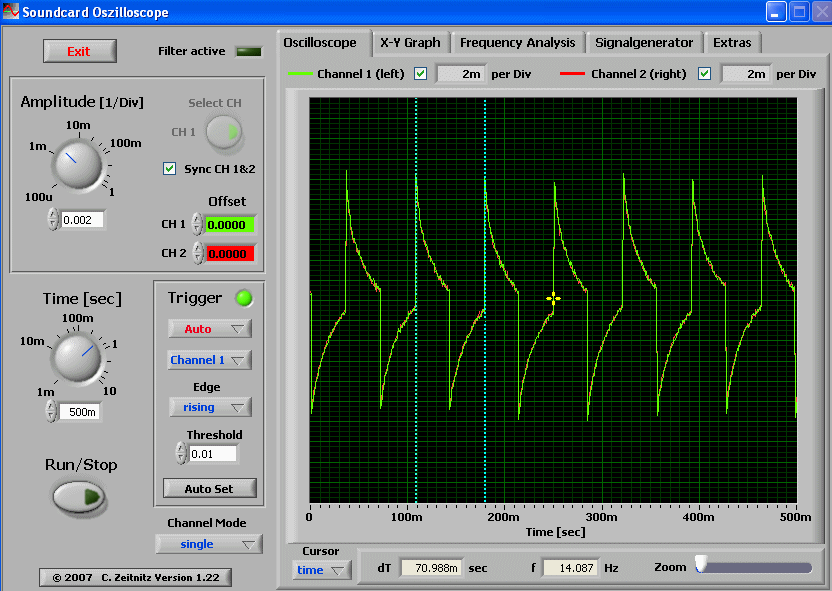
Strobe frequency was measured at a very fast 14Hz. :green:
No PWM (Pulse-Width-Modulation)
Consistent with other Fenix lights, I was unable to detect any signs of PWM. As the runtimes clearly indicate, lower output levels appear to be current-controlled.
As the runtimes clearly indicate, lower output levels appear to be current-controlled.
Testing Method: All my output numbers are relative for my home-made light box setup, a la Quickbeam's flashlightreviews.com method. You can directly compare all my relative output values from different reviews - i.e. an output value of "10" in one graph is the same as "10" in another. All runtimes are done under a cooling fan, except for the extended run Lo/Min modes (i.e. >12 hours) which are done without cooling.
Throw values are the square-root of lux measurements taken at 1 meter from the lens, using a light meter.
Throw/Output Summary Chart:
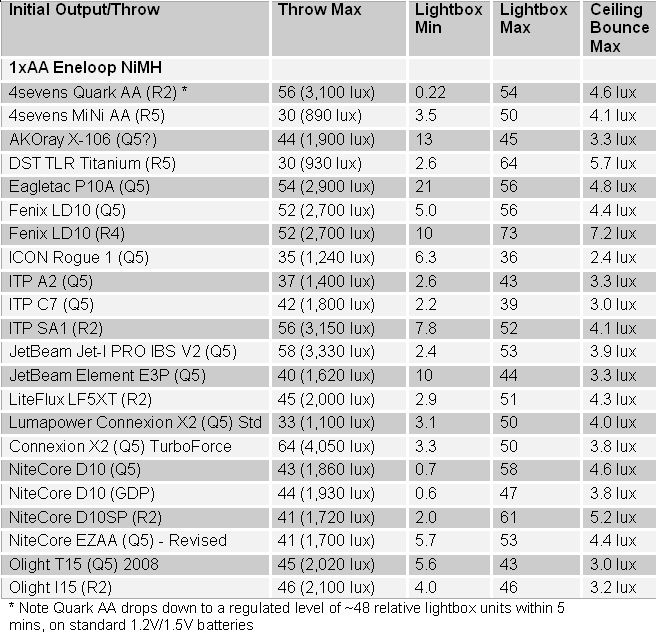
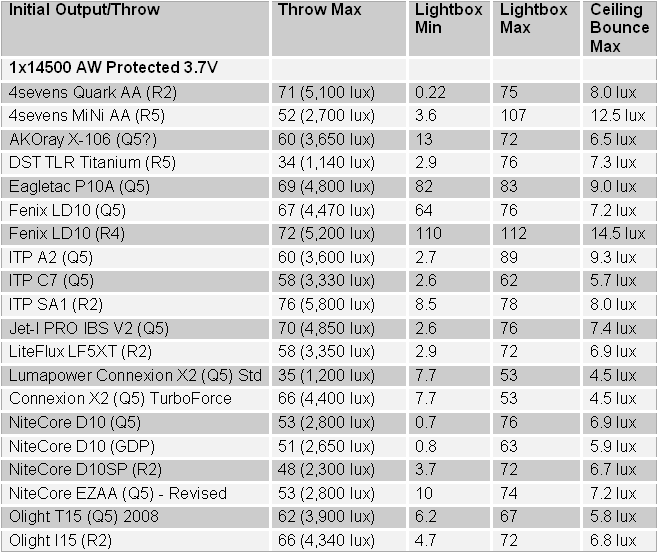
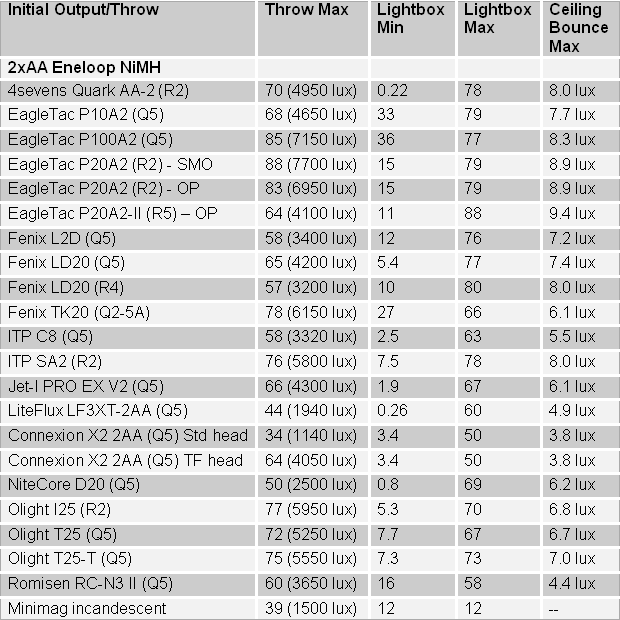
Ok, this is where things start to get interesting.
Turbo output of the LD10-R4 on standard batteries is remarkably high – higher than any other 1xAA light I've tested. oo: On previously models, Turbo wasn't noticeably brighter than Hi mode. At least initially, the LD10-R4 is almost as bright as the LD20-R4 on Turbo!
oo: On previously models, Turbo wasn't noticeably brighter than Hi mode. At least initially, the LD10-R4 is almost as bright as the LD20-R4 on Turbo!
Note that the LD10-R4 still lacks defined initial output levels on 14500. :sigh: In other words, the light always comes on in max output direct drive, and regulation only kicks on once the light decays to the regulated output level (at which point the battery is almost exhausted anyway),
The LD20-R4 doesn't seem that much brighter than the earlier generations on Turbo.
Throw is reduced on these new XP-G R4 versions compared to the earlier XR-E Q5s, when matched for the same output level.
The Lo modes of LD10/20-R4s are higher than my first generation LD10/20-Q5s. :shrug: In fact, they are closer to my earlier L1D/L2D-Q5s.
Output/Runtime Comparison:
To start, how do these new XP-G R4 Fenix lights compare with earlier XR-E generations?
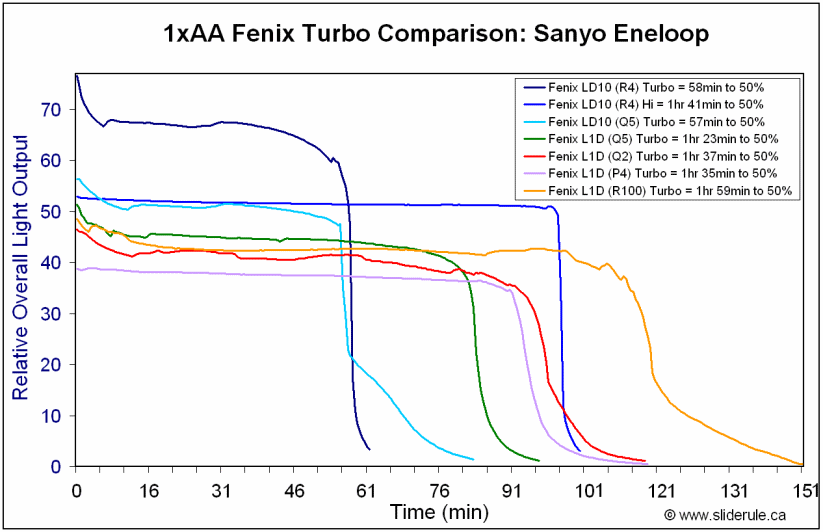
Now that's interesting! For the first time in the history of the L1D/LD10 lineage, the 1xAA light is now much brighter on Turbo than it is on Hi. I've shown the LD10-R4 on Hi to allow you to better compare to earlier lights … but that Turbo performance is very impressive. In fact, the LD10-R4 Turbo is pretty close in initial output to the LD20-R4 (see below).
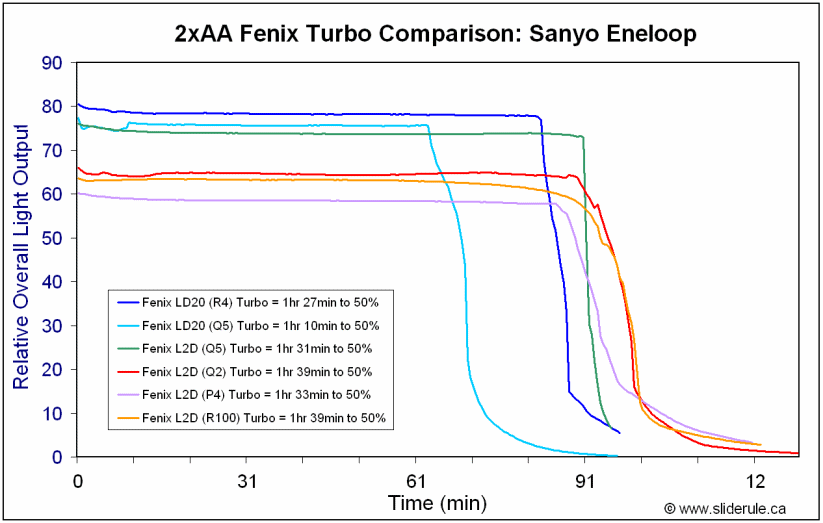
For the LD20-R4, the difference is pretty modest. Yes, there is a small increase in output, and runtime has improved over my LD20-Q5 model. But I suspect most people would have expected to see more of a bump in output here.
How do these new lights stack up to the competition?
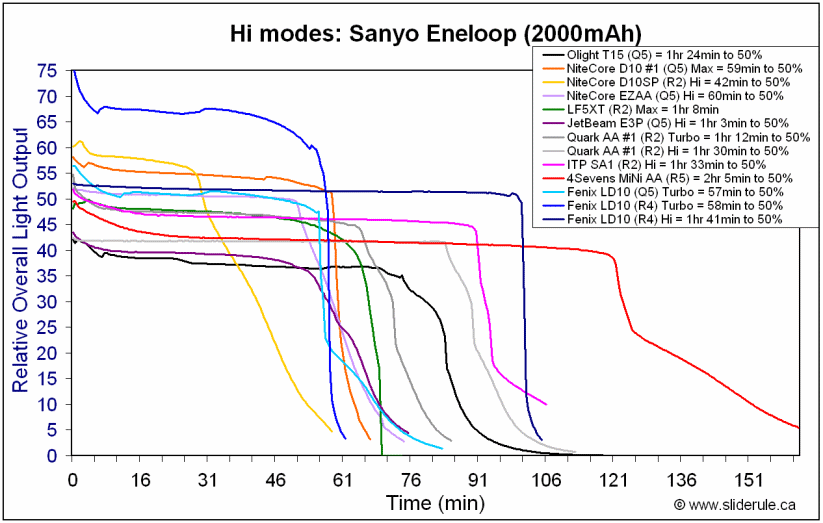
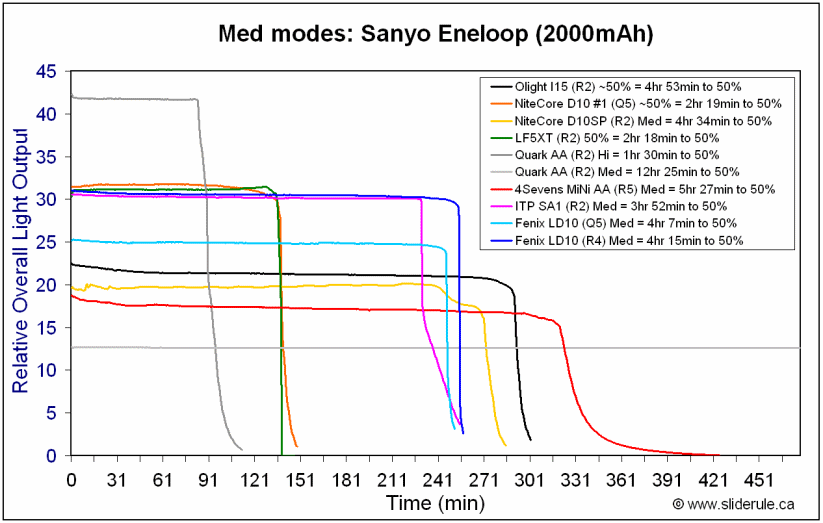
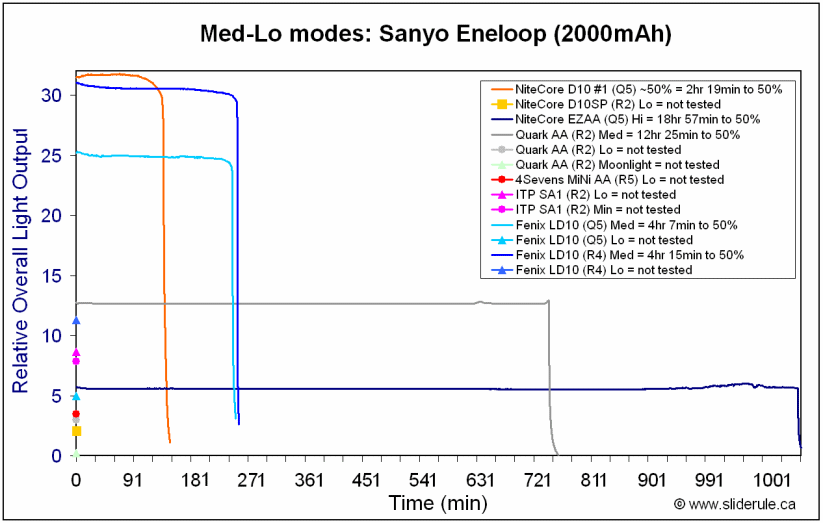
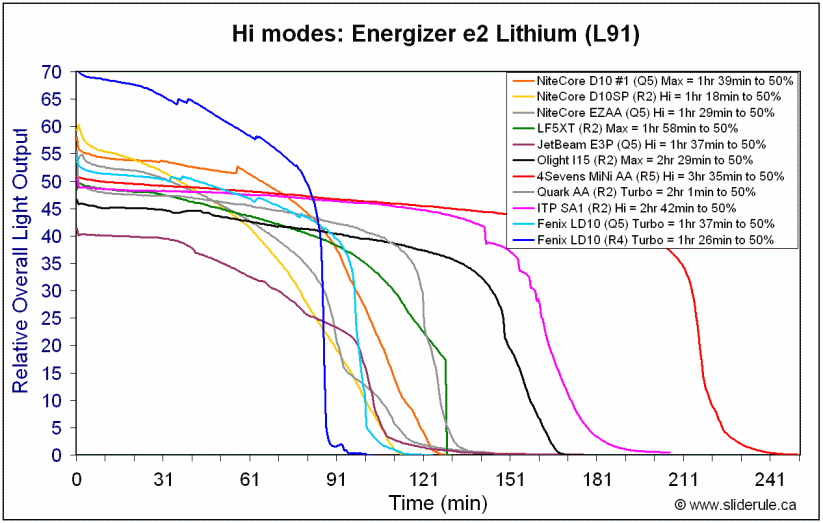
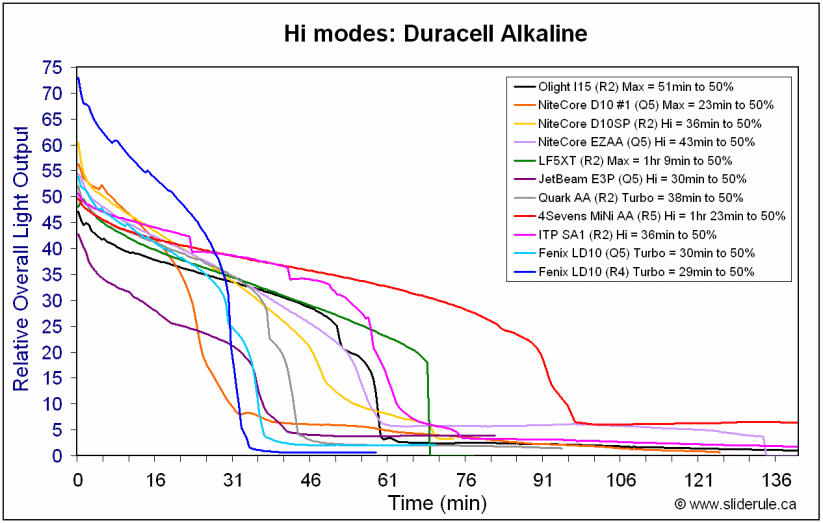
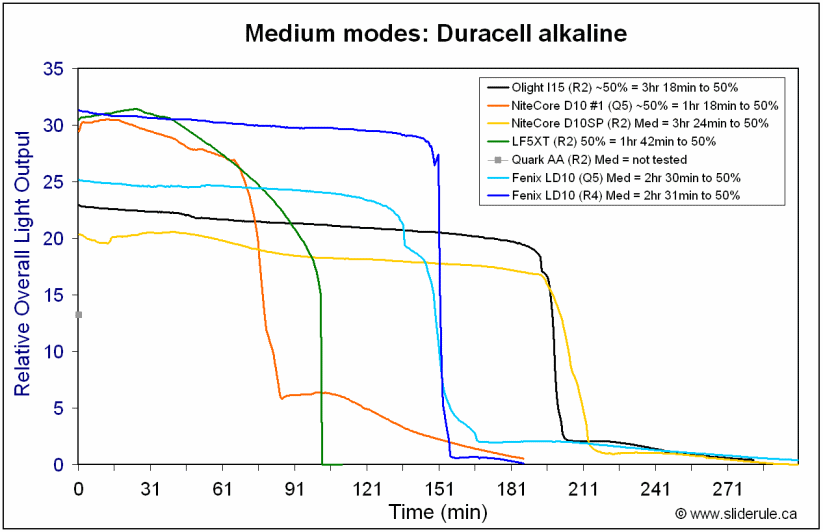
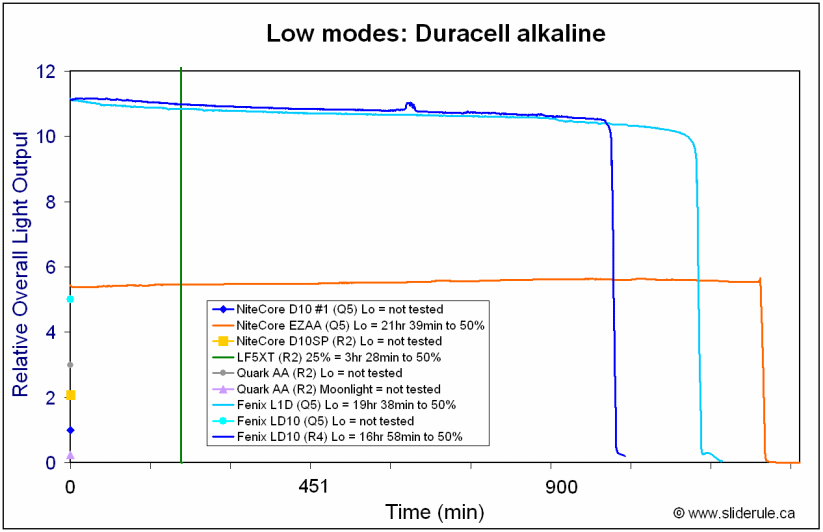

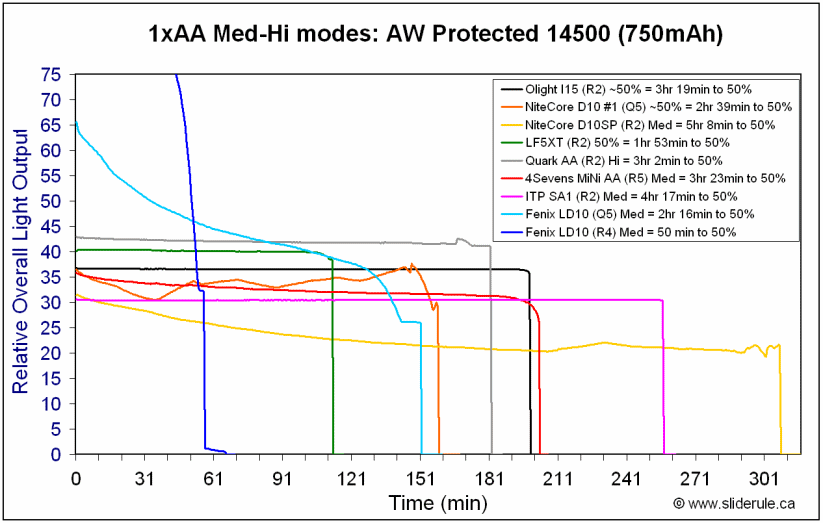
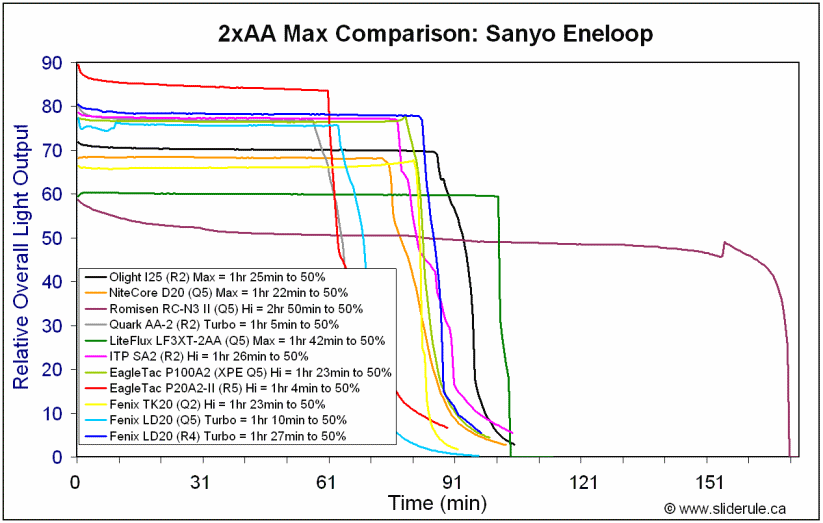
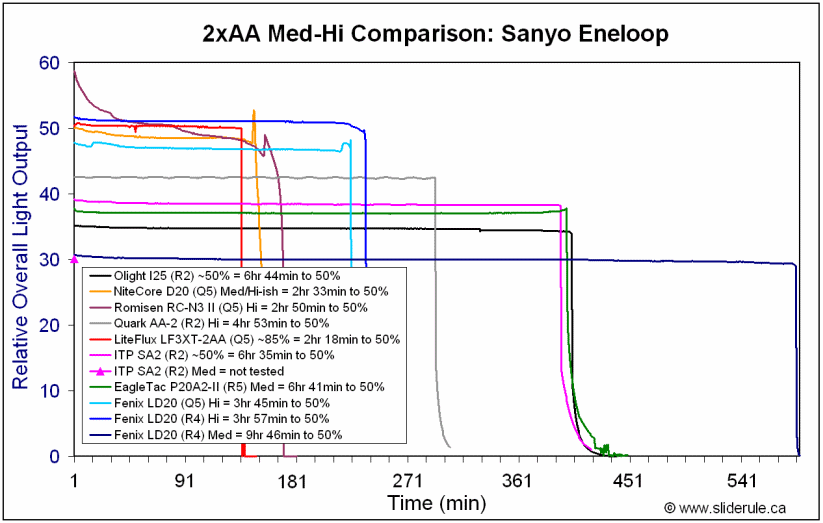
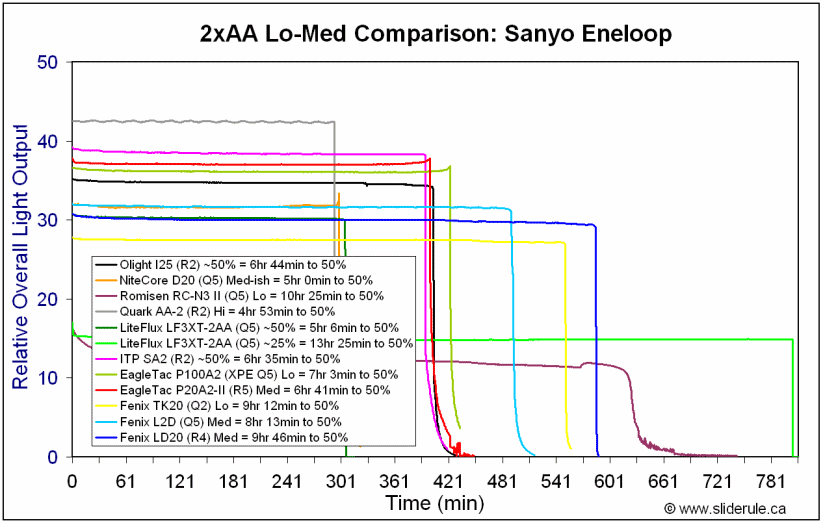
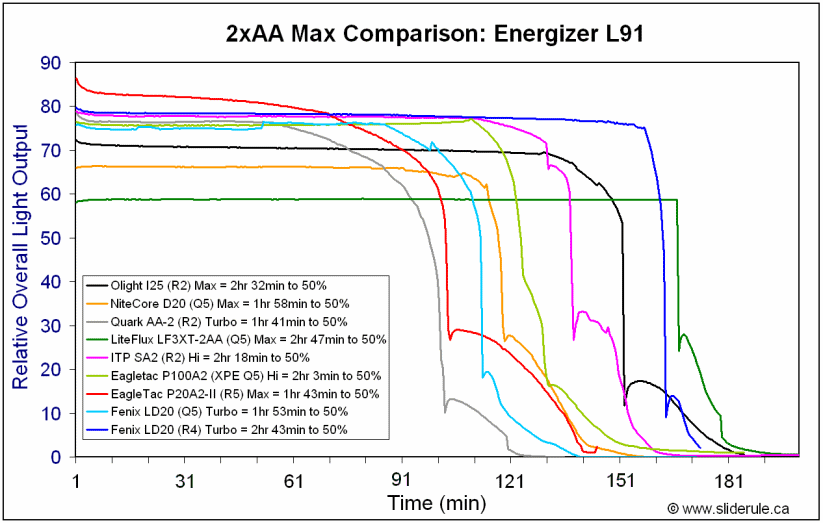
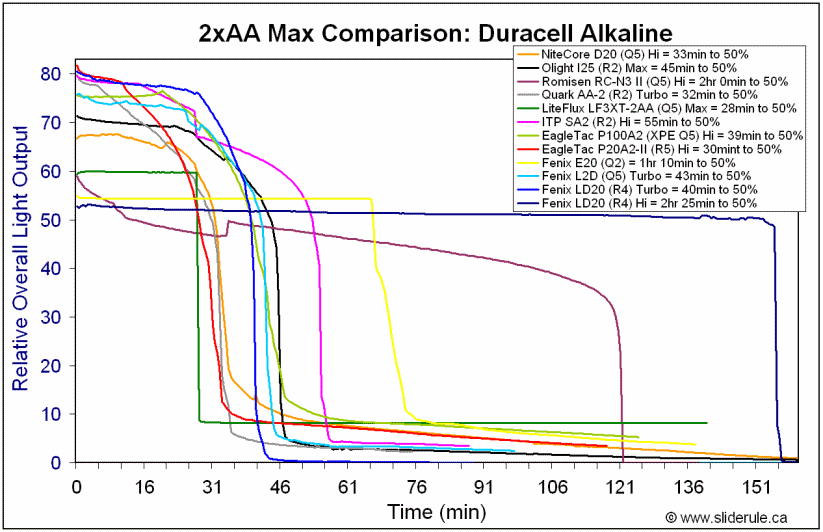
Ok, there's a lot of data up there. :sweat:
Simply put, the LD10-R4 blows away the competition in terms of output on standard cells (NiMH, alkaline, L91). This is a major departure for the line, and I'm impressed that Fenix managed to get the power level up there.
This is a major departure for the line, and I'm impressed that Fenix managed to get the power level up there.
The Turbo output of the LD20-R4 seems a little lack-luster in comparison – it's not that much brighter than my earlier Q5 versions (or the 1xAA LD10-R4 for that matter). In this case, the 2xAA version of this light seems to be optimized for runtime – as expected, at all levels the LD20-R4 beats out the competition for runtime. The Hi mode alkaline run is particularly impressive.
Potential Issues
There is a quirk in the circuit in 2xAA form – you loose the Lo-Med modes on 2xL91 lithium batteries initially (i.e. Lo and Med are the same as Hi at first). I recall something similar used to happen on the lowest mode of the Olight T25, but in this case, both Lo and Med are affected on LD20-R4.
I suspect this has something to do with the Fenix lights lacking a buck circuit, and the new XP-G R4 emitters having a relatively lower Vf than previous emitters. As such, any voltage above the emitter's Vf will cause issues. Presumably, after running for some period of time, the voltage of your L91s will drop low enough to fall below the Vf of your emitter, and full multi-mode regulation through the boost circuit will be restored. But how long it will take is hard to predict – it depends on the exact Vf of your sample.
Fortunately, this issue is restricted to 2xL91 – rest assured, all modes work as expected on 1xL91 in the LD10-R4. But of course, 1x14500 is a problem here – as with all earlier versions, the LD10 lacks all defined lower output modes (Lo-Med-Hi) on 3.7V Li-ion. The light instead runs max output direct-drive at all levels, and only enters regulation when the battery is almost exhausted.
As with all XP-G lights with smooth reflectors, there is a slight dark-centre effect in the hotspot (i.e. a faint donut pattern to the hotspot). It is mild on my two samples, but you may want to consider the OP reflector versions, just in this case.
The Lo mode of both my samples is higher than previous LD10/LD20-Q5 versions. Basically, the Lo mode is comparable to the earlier L1D/L2D Q5 versions. If you are looking for a true moonlight mode, you will need to look elsewhere.
The belt pouch seems kind of cheap, compared to earlier Fenix pouches.
General Observations
The LD10/LD20 line is one of the most venerable in Fenix's history – it can trace its way back to the first multi-mode Fenix lights, the L1T/L2T. I think most users will be pleased to see how it has developed with the latest XP-G R4 output editions.
One thing that really stands out for me is the greatly increased output of the LD10-R4 on Turbo on standard batteries (i.e. alkaline, NiMH, L91). This is by far the brightest 1xAA light I've tested to date – initial output is in fact pretty close to the 2xAA LD20-R4.
Put it another way, the LD10-R4 on standard batteries is as bright as most 1xCR123A lights! oo: No doubt about it – if you want to impress someone with how bright a 1xAA light can be on standard batteries, this is one to do it with. :thumbsup:
oo: No doubt about it – if you want to impress someone with how bright a 1xAA light can be on standard batteries, this is one to do it with. :thumbsup:
In comparison to that, I'm afraid you may find the LD20-R4 to be a little lack-luster - Turbo output is only marginally brighter than previous generations. But both regulation and runtime are top-of-the-line for this class of light (2xAA). And though I generally don't recommend alkalines, the LD20-R4 is probably one of the best lights you could run them in (i.e. look at the Hi mode LD20 run).
Basically, the LD20-R4 is the one to turn to if you want the best possible runtime on standard batteries, in a fully regulated fashion. As for the battery quirk of loosing Lo-Med initially on 2xL91, this is part of the flip-side to excellent performance (i.e. no buck circuit, which would reduce overall efficiency). In some ways, it's similar to the continued inability of the LD10 to run multi-modes on 14500 – the circuit isn't designed to fully support >~3V battery sources. :shrug:
Build-wise, I like the extra knurling on the body and good-quality removable clip. Otherwise, not much has changed from previous versions. One exception – the screw threads have been improved to a thicker square-cut type. This means that older style body tube/tailcaps will no longer fit with the new heads – you need to buy modern parts if you want to play "Fenix-lego."
The beam is pattern is quite good on my samples, especially considering that they have a smooth reflector coupled with the XP-G emitter. I believe you can also buy these with OP-reflectors installed (note you can't swap them later!). The main difference with an OP reflector would likely be slightly reduced throw and a greater corona around the hotspot (i.e. smoother transition of spot to spill).
At the end of the day, Fenix continues to show why it's the efficiency-king in these classes of lights - if you are in the market for 1xAA/2xAA light, these deserve serious consideration. I just wish Fenix could come up with a true "moonlight" low output mode – it is one thing this series lacks.
Personally, I don't imagine there is much to compel you to upgrade your earlier Q5-equipped L2D/LD20s to this R4 version (unless you are a real runtime or knurling junky). But the much higher Turbo output of the LD10-R4 is a real eye-opener.
Warning: pic heavy as usual!
Specifications for LD10/20 (R4), adapted from Fenix, Notosora and other websites:
- Cree XP-G R4 LED
- Two modes of output, selected by turning the bezel:
- LD10-R4 General Mode: 9 lumens (34hrs) -> 50 lumens (6hrs) -> 105 lumens (2.2hrs) -> SOS
- LD10-R4 Turbo Mode: 132 lumens (1.5hrs) -> Strobe
- LD20-R4 General Mode: 9 lumens (71hrs) -> 50 lumens (13hrs) -> 105 lumens (5hrs) -> SOS
- LD20-R4 Turbo Mode: 205 lumens (2hrs) -> Strobe
- Digitally regulated for constant brightness
- Uses one (LD10) or two (LD20) 1.5V AA ( Alkaline, NiMH, Lithium ) battery (not included)
- LD10-R4: 100mm (L) x 21.5mm (D)
- LD20-R4: 150mm (L) x 21.5 mm (D)
- Removable titanium-coated steel pocket clip
- Made of T6 aircraft-grade aluminum
- Type III hard-anodized finish
- LD10-R4: 50g weight (excluding batteries)
- LD20-R4: 56g weight (excluding batteries)
- Water-proof to IPX8 standard
- Toughened ultra clear glass lens with AR coating
- Push-button tail cap switch
- Capable of standing up securely on a flat surface to serve as a candle
- Includes a holster, a lanyard, two spare o-rings, and a rubber switch boot
- MSRP: LD10-R4 ~$59; LD20-R4 ~$63
As it just so happens, I have the earlier LD10/20 Q5, as well as all iterations of the original LxD (Q5, Q2, P4 and short-lived Rebel R100) to compare to. Time for a

Since the lights use the same head and come in effectively the same packaging, I will focus on the LD20 for most of the product shots below (the LD10 looks the same, just shorter!

The LD10/20-R4s come in the new standard Fenix packaging. Included inside the thin cardboard box with molded plastic insert is the light along with a manual, warranty card, titanium-coated clip, spare o-rings, extra black tailcap boot cover, wrist lanyard, and belt pouch with closing flap.




From left to right: Duracell alkaline battery, Fenix LD20-R4, Fenix L2D-Q5, 4Sevens Quark AA-2, NiteCore D20, EagleTac P20A2-II.


From left to right: Duracell alkaline battery, Fenix LD10-R4, Fenix LD10-Q5, Fenix L1D-Q5, 4Sevens Quark AA, 4Sevens Mini-AA, NiteCore D10.
Externally, the new LD10/20-R4s appear very similar to the original LD10/20 series lights. The most significant body change is that knurling has been added the body/battery tubes, and seems slightly more aggressive than what was previously used on the tailcaps. Identification labels are clear, although not as bright as the previous versions. Fit and finish are very good on my samples, with no flaws in the matte black type-III hard anodizing. :thumbsup:
New with these lights is the removable Fenix stainless steel pocket clip (with black titanium coating), very similar to the TK12-R5 I reviewed previously.


One thing that has changed is the screw threads – they are now square-cut on both the tail and head sections. While this is a nice feature in-and-of itself, it means the new versions are no longer backward-compatible with the parts from earlier generations. Up until these new lights, you could happily mix-and-match body and tailcap tubes from any previous Fenix version (i.e. LDx0-Q5 all the way down to the original LxD-P4). Now, you will need to stick with parts from this new generation. :shrug:
The tailcap threads are still anodized for tailcap lock-out, like before. Both LD10 and LD20 lights can still tailstand in their default stock forms.


The new LD10/20 uses the new Cree XP-G emitter, with a cool-white R4 output bin (no tint bin reported). As you can see above, my samples came with a smooth reflector, but I believe OP textured is also available. Note that the reflectors are NOT user-swappable. You must buy one version or the other, so make sure you check first if it matters to you.
And now for the white wall hunting.
Note: I accidentally put the wrong labels on the images below – they should all say LD20.




Even with the Smooth reflector, the LD20-R4 has a very even beam with no obvious rings (thanks to the XP-G emitter). It also has a larger and less defined hotspot than the L1D-Q5, with reduced centre-beam throw.
Like with many XP-G-based lights with smooth reflectors, there is some evidence of a slightly dark centre to the hotspot (i.e. a faint donut pattern). This is only noticeable at a distance – and only if you are looking for it. It is not at all distracting in this case.
User Interface
This hasn't changed from earlier model LD10/20 lights. All standard Fenix lights use a similar mechanism – tighten the head for Turbo modes, loosen the head slightly for the General modes.
For General modes, starting with the bezel slightly loosened, click on to activate Lo mode. Soft-press to advance to Med, Hi, SOS in sequence.
With the bezel fully tightened, activation yields Turbo. Soft-press to advance to rapid Strobe.
If you turn the light off-on within ~2 secs, you will advance to the next mode (i.e. acts as a soft-press). If you wait longer than that, you will return to the first output state (i.e. Lo or Turbo, depending on the bezel state). There is no long-term mode memory.

Strobe frequency was measured at a very fast 14Hz. :green:
No PWM (Pulse-Width-Modulation)
Consistent with other Fenix lights, I was unable to detect any signs of PWM.
Testing Method: All my output numbers are relative for my home-made light box setup, a la Quickbeam's flashlightreviews.com method. You can directly compare all my relative output values from different reviews - i.e. an output value of "10" in one graph is the same as "10" in another. All runtimes are done under a cooling fan, except for the extended run Lo/Min modes (i.e. >12 hours) which are done without cooling.
Throw values are the square-root of lux measurements taken at 1 meter from the lens, using a light meter.
Throw/Output Summary Chart:



Ok, this is where things start to get interesting.
Turbo output of the LD10-R4 on standard batteries is remarkably high – higher than any other 1xAA light I've tested.
Note that the LD10-R4 still lacks defined initial output levels on 14500. :sigh: In other words, the light always comes on in max output direct drive, and regulation only kicks on once the light decays to the regulated output level (at which point the battery is almost exhausted anyway),
The LD20-R4 doesn't seem that much brighter than the earlier generations on Turbo.
Throw is reduced on these new XP-G R4 versions compared to the earlier XR-E Q5s, when matched for the same output level.
The Lo modes of LD10/20-R4s are higher than my first generation LD10/20-Q5s. :shrug: In fact, they are closer to my earlier L1D/L2D-Q5s.
Output/Runtime Comparison:
To start, how do these new XP-G R4 Fenix lights compare with earlier XR-E generations?

Now that's interesting! For the first time in the history of the L1D/LD10 lineage, the 1xAA light is now much brighter on Turbo than it is on Hi. I've shown the LD10-R4 on Hi to allow you to better compare to earlier lights … but that Turbo performance is very impressive. In fact, the LD10-R4 Turbo is pretty close in initial output to the LD20-R4 (see below).

For the LD20-R4, the difference is pretty modest. Yes, there is a small increase in output, and runtime has improved over my LD20-Q5 model. But I suspect most people would have expected to see more of a bump in output here.
How do these new lights stack up to the competition?














Ok, there's a lot of data up there. :sweat:
Simply put, the LD10-R4 blows away the competition in terms of output on standard cells (NiMH, alkaline, L91).
 This is a major departure for the line, and I'm impressed that Fenix managed to get the power level up there.
This is a major departure for the line, and I'm impressed that Fenix managed to get the power level up there. The Turbo output of the LD20-R4 seems a little lack-luster in comparison – it's not that much brighter than my earlier Q5 versions (or the 1xAA LD10-R4 for that matter). In this case, the 2xAA version of this light seems to be optimized for runtime – as expected, at all levels the LD20-R4 beats out the competition for runtime. The Hi mode alkaline run is particularly impressive.
Potential Issues
There is a quirk in the circuit in 2xAA form – you loose the Lo-Med modes on 2xL91 lithium batteries initially (i.e. Lo and Med are the same as Hi at first). I recall something similar used to happen on the lowest mode of the Olight T25, but in this case, both Lo and Med are affected on LD20-R4.
I suspect this has something to do with the Fenix lights lacking a buck circuit, and the new XP-G R4 emitters having a relatively lower Vf than previous emitters. As such, any voltage above the emitter's Vf will cause issues. Presumably, after running for some period of time, the voltage of your L91s will drop low enough to fall below the Vf of your emitter, and full multi-mode regulation through the boost circuit will be restored. But how long it will take is hard to predict – it depends on the exact Vf of your sample.
Fortunately, this issue is restricted to 2xL91 – rest assured, all modes work as expected on 1xL91 in the LD10-R4. But of course, 1x14500 is a problem here – as with all earlier versions, the LD10 lacks all defined lower output modes (Lo-Med-Hi) on 3.7V Li-ion. The light instead runs max output direct-drive at all levels, and only enters regulation when the battery is almost exhausted.
As with all XP-G lights with smooth reflectors, there is a slight dark-centre effect in the hotspot (i.e. a faint donut pattern to the hotspot). It is mild on my two samples, but you may want to consider the OP reflector versions, just in this case.
The Lo mode of both my samples is higher than previous LD10/LD20-Q5 versions. Basically, the Lo mode is comparable to the earlier L1D/L2D Q5 versions. If you are looking for a true moonlight mode, you will need to look elsewhere.
The belt pouch seems kind of cheap, compared to earlier Fenix pouches.
General Observations
The LD10/LD20 line is one of the most venerable in Fenix's history – it can trace its way back to the first multi-mode Fenix lights, the L1T/L2T. I think most users will be pleased to see how it has developed with the latest XP-G R4 output editions.
One thing that really stands out for me is the greatly increased output of the LD10-R4 on Turbo on standard batteries (i.e. alkaline, NiMH, L91). This is by far the brightest 1xAA light I've tested to date – initial output is in fact pretty close to the 2xAA LD20-R4.

Put it another way, the LD10-R4 on standard batteries is as bright as most 1xCR123A lights!
In comparison to that, I'm afraid you may find the LD20-R4 to be a little lack-luster - Turbo output is only marginally brighter than previous generations. But both regulation and runtime are top-of-the-line for this class of light (2xAA). And though I generally don't recommend alkalines, the LD20-R4 is probably one of the best lights you could run them in (i.e. look at the Hi mode LD20 run).
Basically, the LD20-R4 is the one to turn to if you want the best possible runtime on standard batteries, in a fully regulated fashion. As for the battery quirk of loosing Lo-Med initially on 2xL91, this is part of the flip-side to excellent performance (i.e. no buck circuit, which would reduce overall efficiency). In some ways, it's similar to the continued inability of the LD10 to run multi-modes on 14500 – the circuit isn't designed to fully support >~3V battery sources. :shrug:
Build-wise, I like the extra knurling on the body and good-quality removable clip. Otherwise, not much has changed from previous versions. One exception – the screw threads have been improved to a thicker square-cut type. This means that older style body tube/tailcaps will no longer fit with the new heads – you need to buy modern parts if you want to play "Fenix-lego."
The beam is pattern is quite good on my samples, especially considering that they have a smooth reflector coupled with the XP-G emitter. I believe you can also buy these with OP-reflectors installed (note you can't swap them later!). The main difference with an OP reflector would likely be slightly reduced throw and a greater corona around the hotspot (i.e. smoother transition of spot to spill).
At the end of the day, Fenix continues to show why it's the efficiency-king in these classes of lights - if you are in the market for 1xAA/2xAA light, these deserve serious consideration. I just wish Fenix could come up with a true "moonlight" low output mode – it is one thing this series lacks.
Personally, I don't imagine there is much to compel you to upgrade your earlier Q5-equipped L2D/LD20s to this R4 version (unless you are a real runtime or knurling junky). But the much higher Turbo output of the LD10-R4 is a real eye-opener.
Last edited by a moderator:


